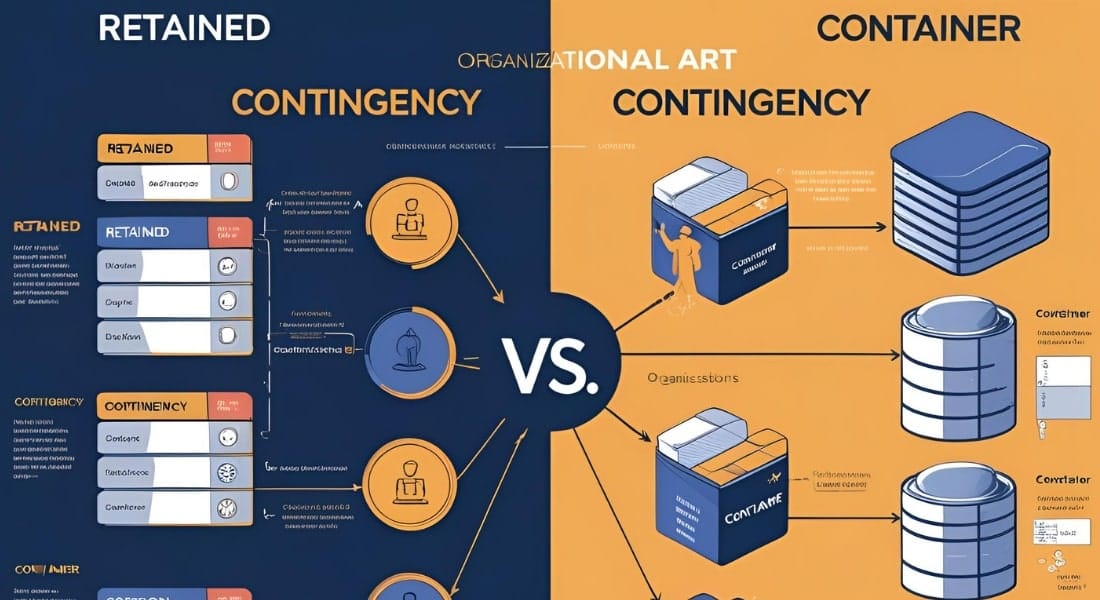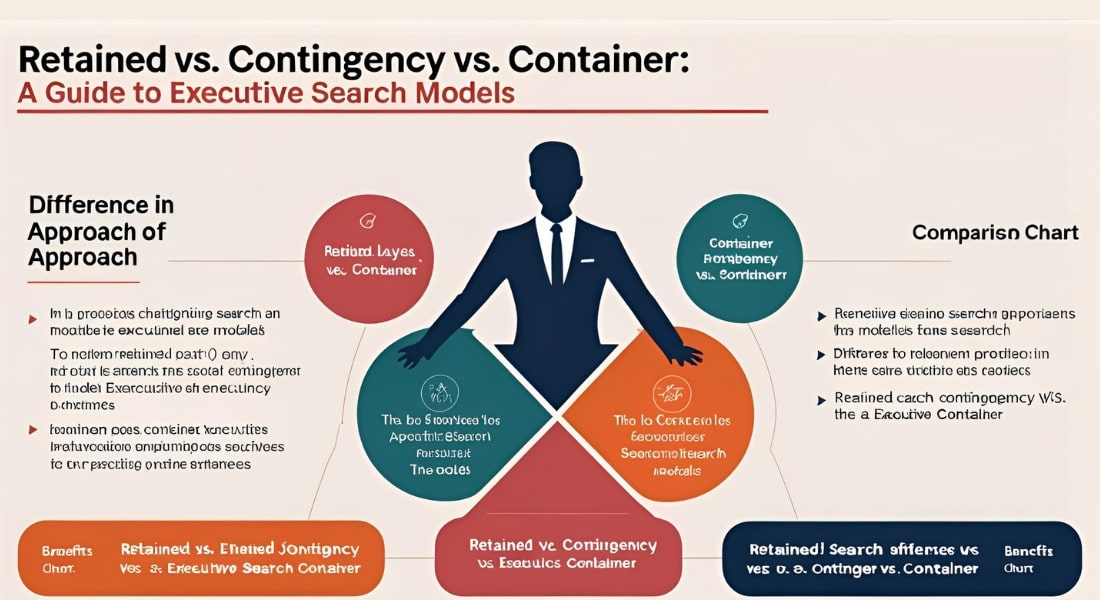When a company is making a mission-critical hire, the stakes couldn’t be higher. The right leader can accelerate growth, shape culture, and chart the future of the business; the wrong one can stall momentum, damage morale, and cost millions in missed opportunities. While much attention is paid to finding the right candidate, there’s an equally important decision that often goes overlooked: choosing the right executive search model.
Not all searches are created equal. Some demand a partner who can move quickly to surface qualified candidates, while others require a discreet, highly tailored process that leaves no stone unturned. Selecting the right model—retained, contingency, or container—can make the difference between a successful hire and a costly misstep.
This article demystifies the three primary models, breaking down their philosophies, cost structures, advantages, and drawbacks. By the end, you’ll have the strategic context to align the right model with your business needs.
The Retained Search Model
Core Philosophy
Retained search is the gold standard for high-level, high-stakes hiring. In this model, the client pays an upfront retainer fee to secure the exclusive services of a search firm. The firm becomes a dedicated, strategic partner—not just a vendor—committed to finding the perfect fit rather than the fastest placement. The relationship is consultative and deep, with the firm working closely with leadership to shape the role, clarify requirements, and execute a thorough search process.
Cost Structure
Retained search firms typically charge a fee equal to 25–33% of the role’s first-year compensation. This fee is divided into three installments: one upfront, another at 30–60 days (often when a shortlist of candidates is presented), and the final installment upon a successful hire. Payment is required regardless of outcome, although most firms offer a replacement guarantee or credit if the hire doesn’t work out.
When to Use
- C-Suite & Executive Roles: For CEO, CFO, CHRO, or other executive hires where leadership impact is enormous.
- Mission-Critical Roles: Positions central to strategy, growth, or transformation.
- Confidential Searches: Situations where discretion is vital, such as replacing an underperforming executive without alerting the market.
Key Advantages
- Exclusivity & Commitment: The firm is fully dedicated to your search, not competing against others. They will continue until the role is filled.
- Strategic Partnership: Beyond candidate sourcing, they provide market intelligence, compensation benchmarking, and advisory input.
- Thoroughness: Retained firms conduct exhaustive research, discreet outreach, and deep vetting, ensuring cultural and strategic alignment.
Key Disadvantages
- Highest Cost: Retained search is the most expensive model.
- Longer Timelines: The depth of the process often extends to 90+ days.
- No Refund Guarantee: Fees are paid regardless of hire, though firms typically mitigate this risk with replacement guarantees.
For companies seeking precision, discretion, and partnership at the highest levels, retained search is the clear choice.
The Contingency Search Model

Core Philosophy
Contingency search is built on speed and competition. Firms are only paid if they successfully place a candidate—a true “no win, no fee” model. Because of this, multiple firms (and sometimes the internal recruiting team) often work the same search simultaneously. The philosophy is simple: whoever delivers the winning candidate first gets paid.
Cost Structure
Fees typically range from 20–25% of the role’s first-year compensation. Payment is made only after the hire is completed, creating minimal upfront risk for the client.
When to Use
- High-Volume or Mid-Level Roles: Ideal for filling multiple similar roles (e.g., sales reps, engineers, customer success managers).
- Non-Confidential Searches: When it’s acceptable for the search to be public and multiple recruiters to reach out to candidates.
- Common Roles: Positions that are neither highly specialized nor mission-critical.
Key Advantages
- Low Upfront Risk: No payment is made until a hire is secured.
- Speed: Firms are incentivized to move quickly and surface candidates from their networks immediately.
- Broad Reach: Having multiple firms competing increases the odds of quickly identifying available talent.
Key Disadvantages
- Lack of Exclusivity: Firms are competing with each other and your own team, which may dilute commitment.
- Shallower Vetting: Because speed is paramount, candidate vetting may be less rigorous.
- Reputational Risk: Multiple recruiters contacting the same candidates can create confusion or damage your employer brand.
Contingency search works best when filling mid-level or common roles quickly, but it is less suited for strategic, confidential, or leadership-level hiring.
The Container Search Model
Core Philosophy
The container model is a hybrid approach that combines the best of retained and contingency search. The client pays a small, non-refundable “container fee” upfront to secure exclusivity and signal commitment. The firm then devotes its resources to the search, but the bulk of the fee is only paid if and when a successful hire is made.
Cost Structure
Typically, 5–10% of the total projected fee is paid upfront as a container fee. The remainder (90–95%) is paid upon placement. The overall fee is similar to a retained model—usually 25–30% of first-year compensation—but with less upfront financial commitment.
When to Use
- Mid-Level to Senior Roles: Important roles that demand focus but are not quite at the C-suite level.
- Testing a Firm: A way to trial a new firm’s services before committing to a fully retained search.
Key Advantages
- Exclusivity: The firm works solely on your search, avoiding the downsides of contingency competition.
- Lower Upfront Risk: Clients invest less upfront, while firms still have a financial incentive to prioritize the search.
Key Disadvantages
- Less Common: Not all search firms offer container arrangements.
- Less Committed than Retained: Because most of the fee is contingent, firms may still push for speed over exhaustive thoroughness.
For companies that want exclusivity without the full cost of a retained search, container offers a pragmatic middle ground.
Conclusion

Choosing the right executive search model isn’t just a financial decision—it’s a strategic one. Each model aligns to different business needs:
- Retained: Best for C-suite, confidential, and mission-critical roles where thoroughness and strategic partnership matter most.
- Contingency: Best for mid-level, high-volume, or non-confidential searches where speed and minimal upfront cost are priorities.
- Container: Best for important roles that aren’t C-suite, or as a way to trial a new firm with lower upfront commitment.
The key is alignment: the more critical and sensitive the hire, the more value retained or container models bring. For less specialized roles, contingency search can deliver efficiency without unnecessary cost.
In today’s competitive talent market, choosing the right search model is as important as choosing the right candidate. Make the model fit the role, and you’ll dramatically improve your odds of making a hire that accelerates—not hinders—your company’s success.


